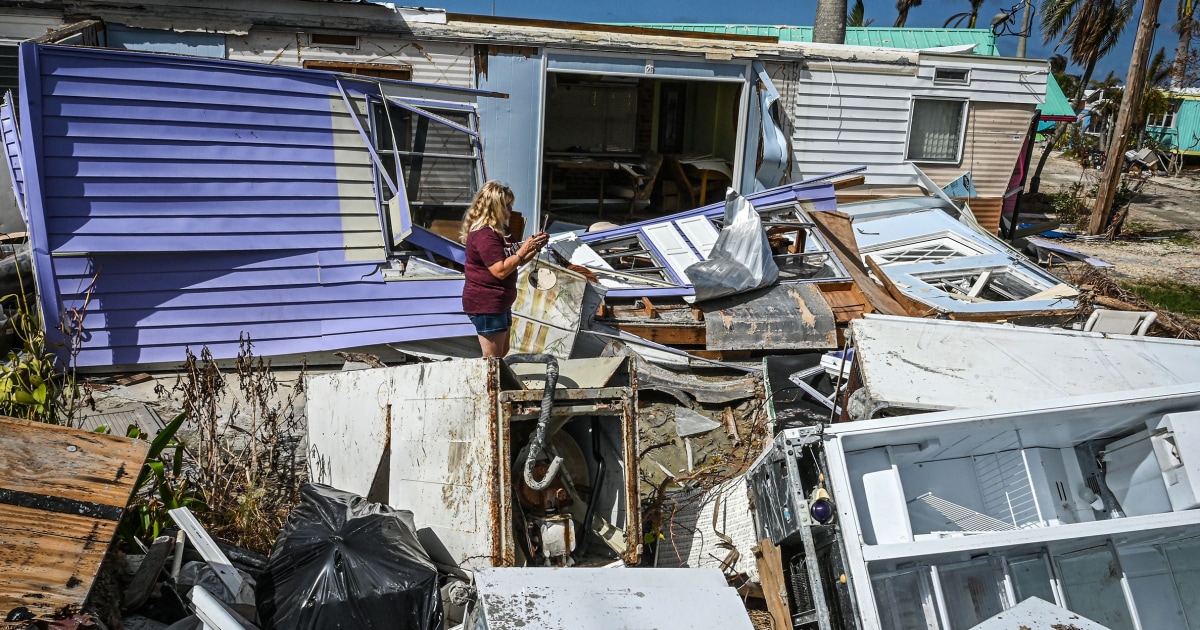By Denise Chow -
NBC News
Stronger, more destructive hurricanes caused by climate change could force a rethink of storm classification, according to a new study that suggests adding a category 6 to classify them and better reflect the speeds of dangerous winds.
The research, published Monday in the journal
Proceedings of the National Academy of Sciences
, examined whether the current
Saffir-Simpson Hurricane Wind Scale
, which ranks hurricanes from 1 to 5 based on the maximum sustained wind speed of a storm, will be enough to communicate the dangers of the most intense storms.
A house destroyed by Hurricane Lee on Matlacha Island, Florida, on November 7, 2022. Giorgio Viera / AFP via Getty Images file
"Our motivation is to reconsider how the open-ended nature of the end of the Saffir-Simpson scale can lead to underestimation of risk and, in particular, how this underestimation becomes increasingly problematic in a warming world," Michael said in a statement. Wehner, the principal scientist at Lawrence Berkeley National Laboratory in California and one of the study's authors.
At the low end of the Saffir-Simpson scale, Category 1 describes winds of 74 to 95 miles per hour (119 to 152 km/h).
At the other extreme, Category 5 is used for storms
with winds of 158 mph (254 km/h) or higher
.
Multiple studies have found that although climate change is not expected to increase the number of hurricanes that strike each year, warmer ocean temperatures will strengthen the ones that do form.
A warmer atmosphere can also hold more moisture, meaning these storms can produce heavier rainfall and catastrophic flooding.
Therefore, the planet can expect more intense storms as global warming continues.
In their study, researchers analyzed hurricanes from 1980 to 2021, and found that five storms in those last nine years had maximum winds greater than 192 mph (308 km/h).
Scientists maintain that these hurricanes could have been classified as Category 6 storms.
The study also used modeling to examine how different climate scenarios could affect hurricanes and other large storms around the world.
They found that if the planet warms 2ºC above pre-industrial levels, the
risk of Category 6 storms could double in the Gulf of Mexico
, a region already prone to strong hurricanes.
According to the researchers, Southeast Asia and the Philippines would also be among the regions most threatened by intensifying storms.
Néstor Serrano walks upstairs in his home in Yabucoa, Puerto Rico, in 2017, after the walls were torn down by Hurricane María. Gerald Herbert / AP file
"Even under the relatively low global warming goals of the Paris Agreement, which aims to limit global warming to just 1.5ºC above pre-industrial temperatures by the end of this century, the increased chances of Category 6 storms are substantial in these simulations," Wehner explained in the statement.
The results add to ongoing debates about how to better communicate to the public the threats of extreme weather events, and the ways in which climate change can multiply them.
Scientists know, for example, that the Saffir-Simpson scale does not reflect some of the
most destructive and potentially lethal
aspects of a hurricane, such as storm surge, precipitation and flooding.
"While adding a sixth category to the Saffir-Simpson scale would not solve this problem, it could raise awareness about the dangers of increased risk of major hurricanes due to global warming," study co-author James Kossin, a climate scientist, said in a statement. and distinguished scientific advisor to the First Street Foundation, a nonprofit research group.
The National Hurricane Center announced Tuesday that it will begin issuing a new experimental tropical storm forecast this summer, updating its current cone charts showing the possible path of a storm.
The new forecasts
will include warnings and alerts for tropical storms and hurricanes
that are in effect for the interior of the country, in an attempt to better convey the risks of winds in the interior during extreme weather events, the agency said.

